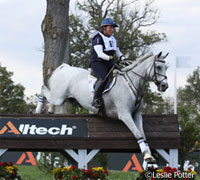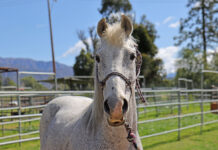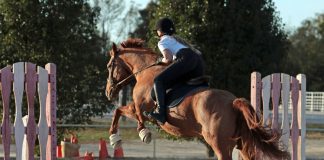 |
| Becky Holder and off-track Thoroughbred Courageous Comet compete at the highest level of eventing. Photo: Leslie Potter |
If you’re in the market for a horse with intelligence, stamina and athletic ability to spare, perhaps you’ve considered an off-the-track Thoroughbred. There are thousands of them coming off the racetrack every year, many of which are still sound enough for long careers as riding horses. One of the appealing things about Thoroughbreds off the track is that they are usually much more affordable than European warmbloods and other sport-bred horses.
Although Thoroughbreds run the gamut from bombproof to explosive, one that’s fresh off the track is definitely not for everyone. “I always try to tell people that an off-the-track Thoroughbred (OTTB) is not the best ‘first’ horse,” says Anna Ford, program director of New Vocations Racehorse Adoption based in Marysville, Ohio, who believes OTTBs are best for prospective adopters who have prior horse-owning experience and confident riding skills.
Finding a Thoroughbred
Many OTTBs are donated to adoption programs, where they will stay until a good a home is found. These programs often assess the horses for suitability to various disciplines and begin the under-saddle retraining process to give you a head start with the horse you choose. Recently retired Thoroughbreds can also be found in sale ads and, of course, at the racetrack.
“There are many great adoption programs out there,” says Ford. “I suggest going with one like New Vocations that specifically focuses on retired racehorses. Since Thoroughbreds are different from other breeds, you will benefit from going to a program that works with them on a daily basis and understands how to handle them.”
Soundness of Body and Mind
Ford recommends writing out a list of what you want in an OTTB before you start your search. This can keep you from being swayed toward an unsuitable horse just because it’s the most attractive one. “If you’re getting a horse that you want to compete, then conformation, soundness and temperament are probably most important to you,” says Ford. “And while there are some racetrack injuries that might prohibit a competitive career, horses that have these may be perfectly fine for a pleasure rider’s needs.”
If you go through an adoption program, once your application is approved, you can ask the program director for help finding a horse that matches your requirements. It’s also a good idea to bring along your trainer when you visit potential horses. “A lot of times, your trainer is going to know what you need more than you do,” advises Ford.
When to Start Work
Deciding whether an OTTB is ready to begin working requires a good dose of common sense; he should be relaxed and happy in his new surroundings first. “We don’t start riding them until they’re mentally and physically sound,” says Ford. “If a horse is physically sound but he’s not eating or is pacing the fence and is unhappy outside, we won’t ask him to do anything until he’s comfortable in his new setting and routine.”
Longe Work
The best work to begin with is longeing. You can do this in a round pen if you have difficulty keeping your horse on a circle in the arena. “Depending on what you’re comfortable with, there’s a lot you can teach your Thoroughbred on the ground before you get on,” says Ford. “It also gives you a chance to get to know your horse and see how he’s reacting to everything.
“On the longeline, you can teach voice commands,” continues Ford. “You can also introduce side reins and teach your horse to start giving to the bit. You can help him become comfortable at a regulated trot and, more importantly, a regulated canter. If your horse lugs on you, side reins will allow him to pull against himself until he figures it out. Longeing also gives you a way to play with different bits to see which one he likes best.” All of these lessons will be extremely useful when you’re ready to saddle up and ride your OTTB.
Although your horse may have appeared sound in the pasture, sometimes lameness will show up when working on a circle. Be sure to address any problems that arise with your veterinarian before proceeding. Your horse may need more time off before going back to work.
Lessons Under Saddle
When you’re ready to mount up, it’s wise to have a ground person hold your horse still, since horses on the racetrack aren’t taught to stand by a mounting block. Jockeys and exercise riders are usually given a leg up while someone is leading the horse at a brisk walk.
Keep your riding routine as similar as possible to what you’ve been doing on the longeline. “If you’ve been working your horse on the longe, then just add a short ride as a continuation, but maybe shorten some of the other steps,” recommends Ford.
“You definitely want to be in an enclosed area, such as an arena or round pen—wherever you’ve been working the horse on the ground. Our first ride with most horses is very short—we just walk around, see if they’re comfortable with that, maybe trot a little bit, and then call it a day. As you get to know your horse, you might not have to longe him first, and you can ride him longer. Just add things as you go.”
As you continue retraining your OTTB under saddle, think of him the same way you would a young or green horse that was recently broke. Work on establishing good rhythm within the gaits, and getting him to accept your leg and steady, elastic contact from the reins. Focus on keeping him moving forward at all times. “Once you get to know your horse, you can change it up a bit,” says Ford. “Try taking him out around the arena or around the farm. That helps some horses calm down a lot, whereas others would prefer to be in the arena. Play around with different things, but remember that OTTBs tend to like routine.”
Schooling the Canter
Before you begin working on the canter, be sure your horse has a solid walk and trot. “If he’s rushing at the trot, he’s just going to be running off with you at the canter,” says Ford. “If your horse can do a collected, balanced canter on a 20-meter circle on the longeline, then he’s more likely to do it in the arena when you ride him. However, it’s going to be harder for him to pick up the canter if you’re sitting on his back—instead, try sitting in two-point.”
If your horse rushes into the canter, the first several strides might feel too fast, but give him time to settle down to a slower pace. “If you are quiet on your horse, he’ll come back to you,” says Ford.
Once you can walk, trot and canter your horse comfortably, you may want to put down some ground poles or cones to change things up. “I think a horse enjoys that,” says Ford. “But it’s important that any time he acts nervous or upset, you take a step back. Some of our horses might be trotting over ground poles within the first week under saddle because they’re so confident with the environment and with themselves, whereas it might take two months to get to that point with other horses. It’s important to understand the individual horse.”
Establishing Brakes
Starting your horse out on the longeline has many benefits, including teaching the verbal cue for “whoa.” This will help your horse put the aids together under saddle if used in conjunction with the verbal cue. If your horse continues to rush when ridden, try slowing your posting or doing a lot of walk-trot transitions. “As soon as you feel your horse starting to rush, bring him down to the walk; he will catch on,” advises Ford. “Many times, by slowing your posting, your horse will slow down his pace as well. One of the things that scares people is that an OTTB’s trot feels faster than they’re used to, but that’s the speed they’ve been taught to jog at the track.”
Try riding your horse on a circle to keep him from rushing. “Adding things such as serpentines and figure-eights will also help to refocus your horse, so he’s not thinking go-go-go,” says Ford. Try to stay confident when your horse gets quick, patiently taking a step back in training if necessary until he learns to slow down.
Turning and Bending
Some Thoroughbreds coming off the track may feel stiff as a board to ride, particularly in one direction (typically to the right, since they are hotwalked and raced to the left). Your longe work with loosely adjusted side reins will gently accustom your horse to bending on a 20-meter circle in both directions.
OTTBs can have trouble on the straightaway, as well. “We try to work on going straight, and using the whole arena,” says Ford. “Keep your horse straight down the long sides and then just slightly bend on the turns.”
A lot of OTTBs have the habit of dropping their shoulder on turns. The earlier you can start to work your horse off your leg, the better. “If he’s really bad, you might want to wear small spurs; when he feels the spur, he will start to pick up his shoulder,” says Ford. “Once you’re under saddle, using circles, serpentines and figure-eights to constantly bend them, it gets more difficult for them to drop their shoulder; most of them will start to bend pretty well.”
Keep in mind that you can never have enough patience when it comes to reprogramming a horse’s training. Your horse’s past experiences might lead to occasional problems in behavior, but with time, your patience can pay huge rewards. There is nothing like an athletic and responsive Thoroughbred that is well-schooled for his new career as an unflappable trail horse, flashy hunter or agile eventer.
Senior Associate Editor Holly Werner has owned three OTTBs and finds them ideal for her sport of eventing.
This article originally appeared in the April 2010 issue of Horse Illustrated. Click here to subscribe.






Great article! I have had my 6 yr old OTTB for a year. I got him straight off the track and while I don’t regret it, he can be a handful! I would definately recomend wourking with a trainer because as great as these horses are, they have issues that it can be hard to work out yourself. They are really fun and very athletic though!
Yep, I definitely remember the last two. My horse ended up being left-handed or left-sided.